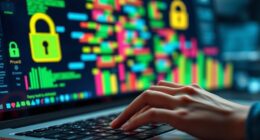To mitigate personal bias and guarantee objectivity in data analysis, actively question your assumptions and remain vigilant against preconceived notions. Use tools like automated bias detection and document your data sources, transformations, and methods. Regularly review your procedures to catch errors early and promote transparency through peer review. Maintaining this ongoing effort helps keep your analysis fair, accurate, and trustworthy. If you continue exploring, you’ll discover more strategies to strengthen your objectivity.
Key Takeaways
- Implement standardized protocols and checklists to minimize subjective influences during data collection and analysis.
- Use automated bias detection tools and statistical methods to identify and correct personal biases.
- Promote transparency by documenting methodologies, data sources, and transformations for peer review.
- Regularly question assumptions, challenge prevailing hypotheses, and seek diverse perspectives to reduce bias.
- Foster a culture of continuous review, training, and awareness to maintain objectivity throughout the data lifecycle.

Objectivity in data analysis is essential for producing trustworthy results that inform decision-making. When you approach data with an unbiased mindset, you help guarantee that the insights you derive are valid and reliable. One of the key aspects of maintaining objectivity is safeguarding data integrity. Data integrity involves keeping your data accurate, complete, and consistent throughout its lifecycle. By prioritizing data integrity, you reduce the risk of errors that could skew your analysis, making it easier to detect and correct any anomalies early on. This foundation allows you to trust your data and focus on uncovering genuine patterns rather than chasing false leads caused by corrupted or compromised information. Vetted data sources further strengthen your analysis by ensuring the reliability of your inputs. Bias detection is another vital element in mitigating personal biases that may cloud your judgment. As a data analyst, you must remain vigilant for any signs of bias creeping into your process—whether it’s through preconceived notions, selective data sampling, or unintentional favoritism towards certain outcomes. Developing a habit of bias detection involves regularly questioning your assumptions and scrutinizing your methodology. For example, you should check if your data collection methods are fair and representative of the entire population you’re studying. If you notice gaps or overrepresentation of particular groups, you need to address these issues to prevent skewed results. Recognizing bias early helps you maintain the integrity of your analysis and guarantees that your conclusions genuinely reflect reality, not personal or systemic prejudices. To effectively mitigate bias, you should also adopt transparent practices. Document your data sources, transformation processes, and analytical methods so others can review and verify your work. Transparency acts as a safeguard, enabling peer review and collaborative scrutiny, which can reveal potential biases you might have overlooked. Additionally, leveraging automated tools and algorithms designed for bias detection can be invaluable. These tools analyze your datasets for patterns that indicate bias, alerting you to areas that require further investigation. Combining technological assistance with your critical thinking enhances your ability to maintain objectivity throughout the analysis process. Ultimately, achieving objectivity isn’t a one-time effort but an ongoing commitment. Regularly revisiting your data collection procedures, scrutinizing your assumptions, and employing bias detection techniques help sustain data integrity and ensure your findings are as objective as possible. When you prioritize these practices, you foster a culture of accuracy and fairness in your analyses, which ultimately leads to insights that are both trustworthy and actionable. By actively safeguarding against bias and upholding data integrity, you contribute to more credible and impactful decision-making based on your data.
Frequently Asked Questions
How Can Personal Bias Affect Data Interpretation?
Personal bias can skew your data interpretation by introducing cognitive pitfalls and emotional influences. When you rely on preconceived notions or feelings, you might overlook critical patterns or misjudge results. These biases can cause you to confirm what you expect rather than what the data truly shows. To stay objective, you should actively recognize your biases, question assumptions, and use methods like peer review to guarantee your analysis remains balanced and accurate.
What Tools Help Identify Bias in Datasets?
Think of bias detection tools as your guiding lighthouse amidst foggy data seas. These tools, like algorithmic fairness algorithms, shine a light on hidden biases, revealing skewed patterns and unfair disparities. They help you scrutinize datasets with precision, ensuring your analysis remains balanced. By using bias detection tools, you can navigate complex data landscapes confidently, fostering objectivity and fairness in your insights and decisions.
How to Train Analysts to Reduce Bias?
You should train analysts to develop cognitive awareness of their biases and recognize potential blind spots. Encourage them to question assumptions, seek diverse perspectives, and use structured methods like checklists or peer reviews. Regular training sessions and case studies help reinforce these practices. By fostering an environment where analysts remain vigilant about their biases, you guarantee more objective data analysis and improve decision-making accuracy.
Are There Industry Standards for Objective Data Analysis?
Yes, industry standards for objective data analysis exist, emphasizing standard practices like transparent methodology, rigorous validation, and unbiased interpretation. You should also follow ethical guidelines that promote integrity, confidentiality, and accountability. Adopting these standards helps guarantee your analysis remains impartial and credible. While specific practices vary across sectors, embracing these core principles guides you toward maintaining objectivity and upholding professional integrity in your data work.
How Does Bias Influence Decision-Making Processes?
Bias can cloud your judgment like a foggy lens, leading you to favor information that confirms your existing beliefs. Confirmation bias and cognitive distortions distort decision-making, causing you to overlook critical data. For example, if you ignore evidence contradicting your hypothesis, your choices become skewed. Recognizing these biases helps you make more objective decisions, ensuring data drives your actions rather than personal assumptions.
Conclusion
Just as the myth of Pandora’s box reminds us of the chaos unleashed by unchecked curiosity, your commitment to objectivity keeps bias at bay. By actively recognizing your personal influences, you prevent them from distorting your data. Stay vigilant, question assumptions, and embrace transparency. Remember, in the quest for truth, your awareness is the key that seals Pandora’s box, ensuring your analysis remains clear, reliable, and free from the shadows of bias.










